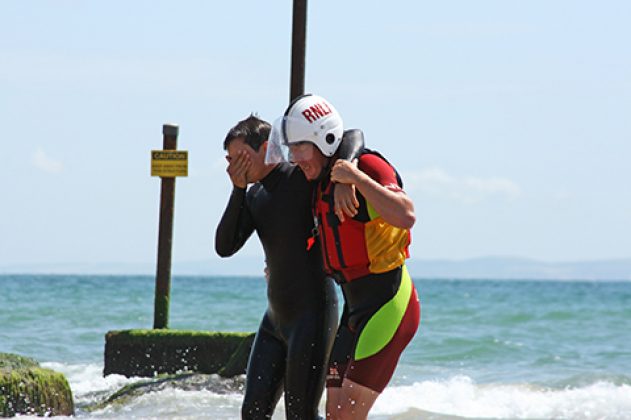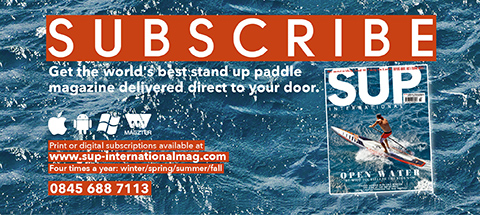FIRST AID –
#1 THE PRIMARY SURVEY
Words – Gordon Ingram
Paddleboarder and paramedic Gordon Ingram presents a series of practical first aid considerations for home and abroad…
We are all aware that the world is becoming more accessible and paddlers are having to travel further afield in the quest to find perfect, uncrowded waves and with this the element of risk increases.
Things do not always go to plan and sometimes s#*t happens. It is one problem when somebody gets injured whilst paddling in the UK, but it is a completely different scenario when someone gains a similar injury in the middle of nowhere, where medical assistance may not be just a simple phone call away.
Many of you will have participated in a first aid course, some of you may be highly qualified lifeguards, some may be paramedics and some may be proper grown-ups and work as doctors. For those of you out there who have not got experience in first-aid then I urge you to enrol in a course. It may be a case that the life you save will be that of a friend.
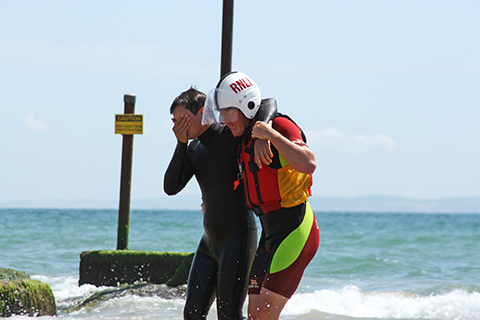
// He’s had a shocker, but is in safe hands now. Photo RNLI
Remember: injuries don’t just happen while you are paddling:-
You are involved in a car crash on the way to the surf, you pass an incident involving local people in a foreign land, the country you are in is in political unrest and things go ‘pop’, or the universe decides to show us how small we are and a natural disaster occurs whilst you are there. Any of these would be traumatic to encounter. The chances are that you are going to offer assistance in one way or another (all of these examples have happened to European surfers in the past, in this country and abroad) and it is vital to at least know the basics.
There is one thing that is written in stone, it doesn’t matter where you are or what training you have, the initial approach to any patient will be the same: ‘The Primary Survey’. Obviously, if you have more knowledge and more equipment you can deal with incidents at a deeper level but with no kit available then everyone is in the same boat.
“ For those of you out there who have not got experience in first aid then I urge you to enrol in a course. It may be a case that the life you save will be that of a friend ”
So, what is the primary survey?
The Primary Survey is a systematic approach to rule out any life threatening conditions and is one of the most difficult things to carry out whilst a person is screaming in agony – the fractured limb they have sustained is probably not going to kill, but a hidden chest injury may well.
Many of you will have heard of the DR ABC approach to a patient. This is a good system to follow but we are going to take things a step further.
If someone has suffered a traumatic injury then we need to use some common sense:
• Is it safe for me to help?
• Is he/she conscious?
• Do I need some help?’
• That’s a LOT of blood!
• Have they been sick?
• Is he/she breathing?
• Is their circulation ok?
• Have they suffered a head injury?
• Do I need to get them out of here and somewhere safe?
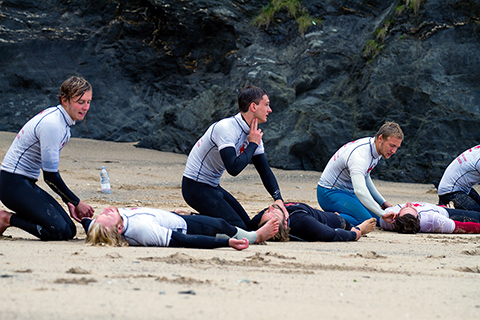
// Primary survey training saves lives. Photo First Response GB
In essence we have just covered the Primary Survey:
DR C ABCDE
D – Danger Am I going to put myself in danger if I try and help?
R – Response Is the patient conscious, are they talking, do they open their eyes when you shout at them, if you pinch their ear lobe do they respond or are they fully unresponsive?
HELP Ensure assistance is heading your way at the earliest opportunity.
C – Catastrophic bleeding Very important in major trauma. If the patient is losing LOTS of blood quickly they are going to die. It needs to be stopped. Think Bethany Hamilton – a leash was used as a tourniquet to stop her losing more blood after a shark attack, if this wasn’t done she may well not have lived.
A – Airway If a patient has a blocked airway then they cannot breathe. It needs to be clear. Simply turning a patient onto their side to allow vomit to drain from the mouth may be all that is required.
B – Breathing Adults breathe approximately 12-20 times per minute. Anything less than 10/minute or more than 30/minute may indicate something is wrong.
C – Circulation Have they got enough blood flowing around the body? Look at their colour, are they pale? If we press our finger on their breastbone for five seconds and release the colour should return in under 2 seconds – if not, there may be a circulation problem. Taking a pulse is great but often difficult in a stressful environment.
D – Disability Here we are looking for signs of a head injury. Has their level of response changed from earlier? Are both pupils the same size or unequal, a tell-tale sign of a head injury?
E – Environment/Evacuate Are they hot or are they cold – Is the patient comfortable? Are we able to get them to safety or are we going to have to wait for help?
If a primary survey is completed and nothing life threatening is found then we can move on to treating any injuries which may be causing pain or discomfort to the patient. Obviously I cannot cover how to treat every eventuality in depth which is why I urge you again to enrol on a suitable course.
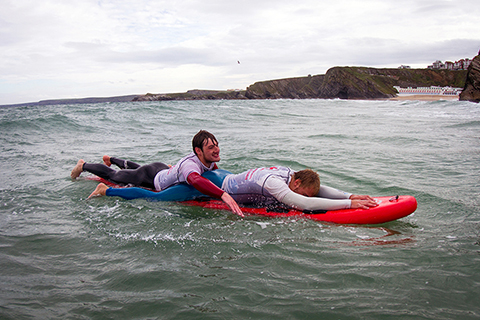
// Develop practical water rescue skills. Photo First Response GB
The majority of injuries you will possibly see are going to fall into the minor trauma category. Reef cuts, sprains, strains, fractures and dislocations. These are will be covered next time!
Take care, stay safe. SUP
For more information on Gordon’s courses visit www.firstresponsegb.com

